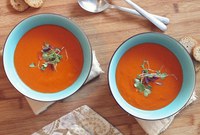Prairie Fare: Are you “souped up” for winter?
(Click an image below to view a high-resolution image that can be downloaded)
I remember coming home after school on a cold winter day to the sound of a hissing pressure cooker. I could hear that vegetable-beef soup was on the menu. The aroma of freshly baked bread often accompanied the sound of the pressure cooker.
I even ate the chunks of rutabagas that showed up in fall vegetable soups.
Many years later, when I was first married, I had to convince my husband about the value of soup.
“Soup is not a meal,” he said. I think he thought of soup as the opening act for the “real food.”
Guess who won this difference of opinion. For decades, we have eaten of all kinds of soup regularly, especially during fall and winter months.
Soup is a warming comfort food, and most of us have a favorite.
Are you “souped up” for winter? The phrase “souped up” goes back more than 90 years according to the dictionary definition.
“Souped up” was applied to vehicles getting optimized for power and performance. Our bodies are somewhat like vehicles. We have an engine in the form of our hard-working heart and muscles to propel us forward, even when we do not feel like shoveling snow.
Maybe you have had a seasonal cold. Chicken soup with vegetables may have helped you feel better.
Soup provides hydration, and the steam emerging from a bowl of soup might actually help when you have a stuffy nose. The vegetables provide vitamins and minerals, and chicken is a good source of protein.
Soup is part of worldwide cuisine. Have you tried cold tomato-based gazpacho soup of Spain during warmer months? How about minestrone soup from Italy, beet-based borscht soup that originated in Russia, clam chowder from New England, egg drop soup that is popular in China, Vietnamese pho that makes use of bone broth, onion and ginger, or lentil soup from the Middle East?
These soups with international origins can form the basis of an exploration of recipes during cold winter months.
Soup can help optimize our nutrition and perhaps our health. Soup is high in liquid, so it is hydrating and often lower in calories.
Consider these tips to optimize the nutritional properties of soup:
- Use vegetable, chicken or beef broth with less sodium. Or, make your own stock using leftover chicken or turkey bones, vegetable scraps and water.
- Add extra vegetables to your soup. We often shortchange ourselves on vegetable consumption. The current recommendation for most adults and kids is 2 ½ cups per day, on average. Vegetables provide vitamins, minerals and fiber. To stretch your food dollar, you can add leftover vegetables from the previous night’s meal to soup.
- If you purchase soup as an ingredient, compare the sodium content. Some types of soup provide more than half the day’s recommendation of sodium in one serving.
- Instead of adding salt, enhance the flavor of soup with the addition of fresh herbs toward the end of cooking.
- Add some pulse foods (kidney beans, chickpeas, lentils) to your soup, which enhances the protein and fiber content.
- Add some pearled barley, brown rice or whole-grain pasta.
- Choose lean meats when making soup. Chill the soup and skim the fat that often congeals on top of the soup.
- If making a creamy soup, consider using half and half or milk instead of cream to reduce the fat and calories.
Here’s one of my all-time favorites, tomato-basil soup. You can substitute drained, canned whole tomatoes for fresh tomatoes if you’d like. Enhance their flavor by roasting the canned tomatoes in the oven. Tomato soup is especially delicious with grilled cheese sandwiches on whole-grain bread.
Rustic Tomato Basil Soup
2½ pounds fresh, ripe tomatoes, halved (or drained, canned tomatoes)
4 tablespoons olive oil
½ tablespoon salt
1 teaspoon black pepper, plus more to taste
2 medium onions, chopped
10 garlic cloves, chopped
2 (14½-ounce) cans fire-roasted tomatoes with juices
3 cups fresh basil leaves, lightly packed
2 teaspoons dried oregano
6 cups unsalted vegetable stock
1 teaspoon sugar, depending on sweetness of tomatoes
Preheat oven to 400 degrees. In a large rimmed sheet pan, combine the fresh tomatoes, 2 tablespoons olive oil, salt and pepper. Roast in an even layer for 45 to 60 minutes. While tomatoes are roasting, in a large heavy pot saute onions in olive oil for one minute. Add garlic and saute another minute. Add the fire-roasted tomatoes with juices, fresh basil, oregano and vegetable stock. Stir to combine well.
Add your oven-roasted tomatoes (and any liquid that may be on baking sheet) and bring to a low boil. Simmer for 30 minutes uncovered. Use an immersion blender or food processor to puree soup until desired texture. Add 1 teaspoon of sugar to taste, if needed. Add additional salt and/or black pepper as needed.
Makes six (2-cup) servings. Each serving has 200 calories, 10 grams (g) fat, 4 g protein, 24 g carbohydrate, 2 g fiber and 510 milligrams sodium.
(Julie Garden-Robinson, Ph.D., R.D., L.R.D., is a North Dakota State University Extension food and nutrition specialist and professor in the Department of Health, Nutrition and Exercise Sciences.)
NDSU Agriculture Communication – Nov. 9, 2023
Source: Julie Garden-Robinson, 701-231-7187, julie.garden-robinson@ndsu.edu
Editor: Elizabeth Cronin, 701-231-7881, elizabeth.cronin@ndsu.edu




